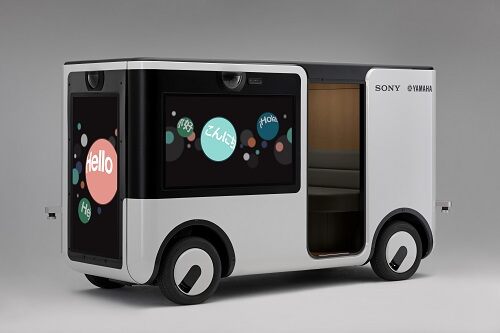 In Augmented Reality and Mixed Reality News
In Augmented Reality and Mixed Reality News
August 22, 2019 – Sony Corporation has announced the joint development with Yamaha Motor Co., Ltd., of the SC-1 Sociable Cart. Sony and Yamaha Motor plan to launch services using the SC-1 in Japan in fiscal 2019. The vehicle was developed solely for the purpose of providing a new mobility experience, and it will not be made available for sale, according to the companies.
The SC-1 is designed to transform a means of mobility into an all-new opportunity for entertainment, with Sony and Yamaha Motor stating that they will deploy it to provide new diversion experiences at venues such as golf courses, amusement parks, and commercial facilities.
Sony developed the vehicle’s proof-of-concept prototype in 2016 and completed the SC-1 New Concept Cart prototype in 2017. Then, in 2018, Sony and Kanucha Bay Resort Co., Ltd. joined forces to use the SC-1 to provide Moonlight Cruise, a limited-time ride experience service where customers were able to enjoy video and audio entertainment powered by augmented reality projected against the backdrop of night scenes at a golf course in Okinawa.
Sony stated that the SC-1 Sociable Cart was jointly developed with Yamaha Motor based on the feedback accumulated from Moonlight Cruise and various other driving tests. The new model has increased passenger capacity (up from three to five persons), extended run time thanks to replaceable batteries, a broader front and rear scope of view due to additional image sensors, a more comfortable ride as a result of optimization of the base vehicle, as well as other improvements.
Unlike other human operated modes of transport, the SC-1 features image sensors on all sides of the vehicle, which provide images that are in-focus in all directions and allow the SC-1 to sense the surrounding environment. Moreover, the ultra-high sensitivity characteristics of the image sensors and the high-resolution display installed inside the vehicle allows passengers to see their surroundings at night, even without any headlights. In addition to normal operation by passengers, the SC-1 can also be operated remotely by someone viewing the images via the cloud.
With the SC-1’s surroundings captured by sensors, the vehicle does not require windows. Instead, high-definition displays are installed in the areas where windows would otherwise be, which can be used to stream advertising and other content to people outside the vehicle. Furthermore, images obtained via the image sensor are able to be analyzed with artificial intelligence (AI), which can determine the attributes (age, gender, etc.) of people outside the vehicle and optimize ads and other streaming info accordingly, thus enabling interactive content to be streamed.
The SC-1 also incorporates mixed reality technology developed by Sony that can superimpose computer graphics onto the surroundings being displayed on the monitor. This turns the area that used to be taken up by windows into an entertainment area, where graphics can be overlaid on top of the scenery being displayed.
In addition to the image sensors, the SC-1 is also equipped with ultrasonic sensors and a two-dimensional laser image detection and ranging (LIDAR) system. This makes it possible to accumulate travel data in the cloud for deep learning analysis, which in turn supports optimized driving. This also enables the use of edge computing to process information obtained from the vehicle’s sensors to provide safer travel, according to Sony.
Image credit: Sony/Yamaha Motor
About the author
Sam Sprigg
Sam is the Founder and Managing Editor of Auganix. With a background in research and report writing, he has been covering XR industry news for the past seven years.




